Essay: Humanities, Critical Thinking, and Their Impact on Society
VerifiedAdded on 2022/12/29
|6
|1836
|3
Essay
AI Summary
This essay delves into the significance of humanities and critical thinking in understanding human culture and society. It begins by defining humanities and critical thinking, highlighting their importance in various fields and their role in fostering creativity, reasoning, and critical analysis. The essay then explores the connection between culture, myth, and history through the example of Antoine-Louis Barye's bronze sculpture of Theseus slaying the centaur, drawing parallels to Greek mythology and its influence on art and culture. Furthermore, the essay emphasizes the interconnectedness of humanities and sciences, and the value of humanities in interpreting the world from different perspectives. It underscores the importance of critical thinking skills in personal and professional development, including effective communication, problem-solving, and empathy. The essay concludes by reiterating the value of humanities in providing skills necessary for success in various aspects of life.
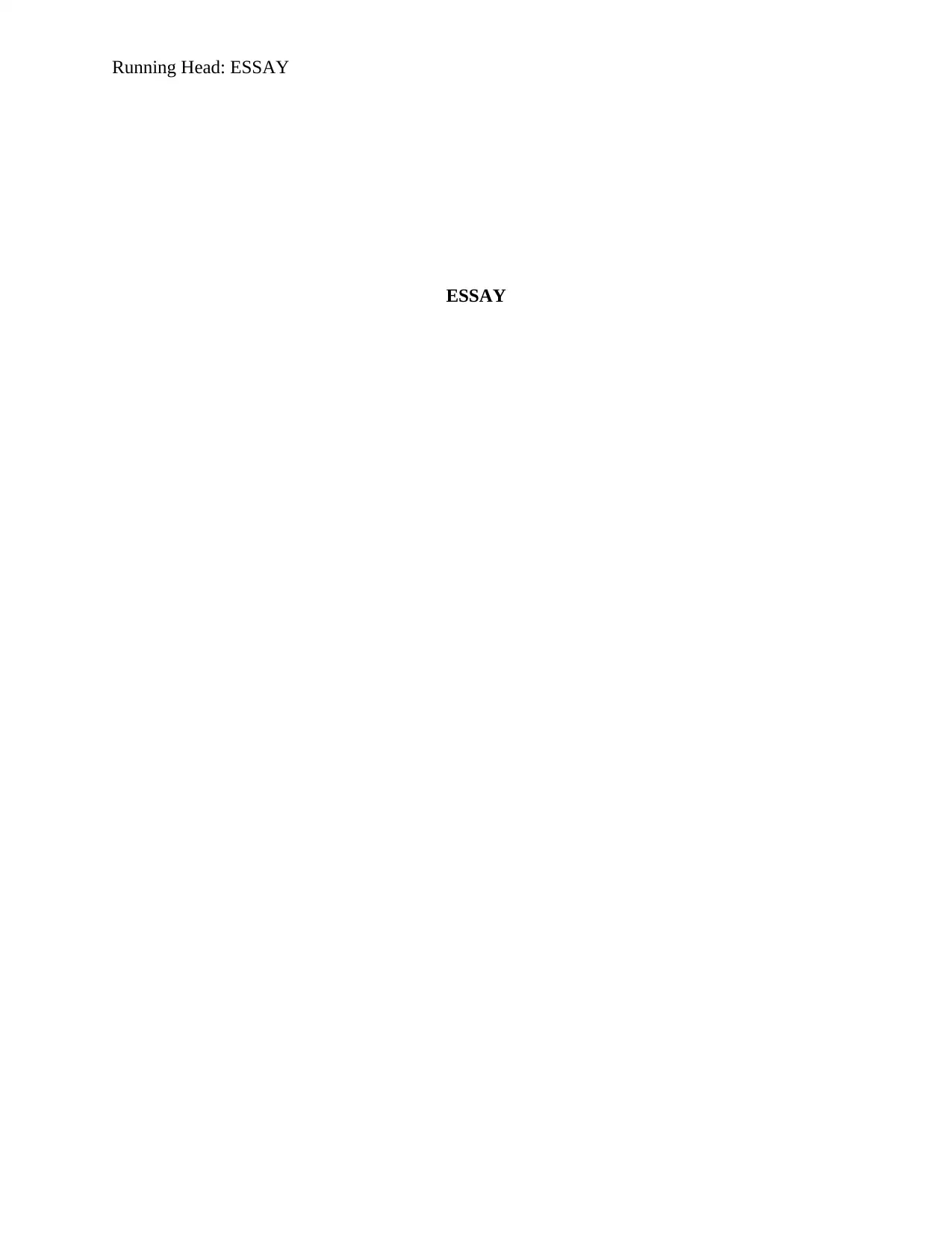
Running Head: ESSAY
ESSAY
ESSAY
Paraphrase This Document
Need a fresh take? Get an instant paraphrase of this document with our AI Paraphraser
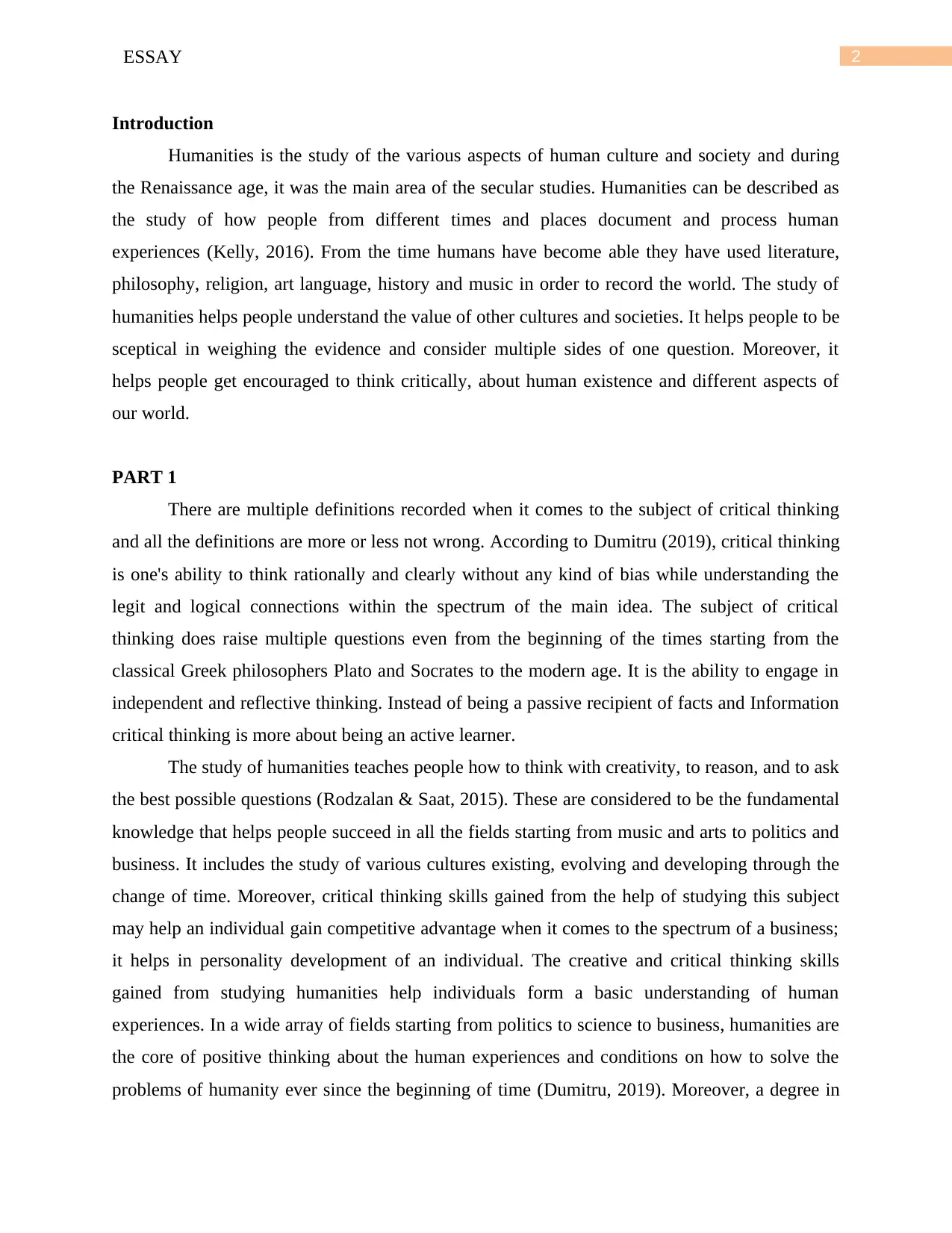
2ESSAY
Introduction
Humanities is the study of the various aspects of human culture and society and during
the Renaissance age, it was the main area of the secular studies. Humanities can be described as
the study of how people from different times and places document and process human
experiences (Kelly, 2016). From the time humans have become able they have used literature,
philosophy, religion, art language, history and music in order to record the world. The study of
humanities helps people understand the value of other cultures and societies. It helps people to be
sceptical in weighing the evidence and consider multiple sides of one question. Moreover, it
helps people get encouraged to think critically, about human existence and different aspects of
our world.
PART 1
There are multiple definitions recorded when it comes to the subject of critical thinking
and all the definitions are more or less not wrong. According to Dumitru (2019), critical thinking
is one's ability to think rationally and clearly without any kind of bias while understanding the
legit and logical connections within the spectrum of the main idea. The subject of critical
thinking does raise multiple questions even from the beginning of the times starting from the
classical Greek philosophers Plato and Socrates to the modern age. It is the ability to engage in
independent and reflective thinking. Instead of being a passive recipient of facts and Information
critical thinking is more about being an active learner.
The study of humanities teaches people how to think with creativity, to reason, and to ask
the best possible questions (Rodzalan & Saat, 2015). These are considered to be the fundamental
knowledge that helps people succeed in all the fields starting from music and arts to politics and
business. It includes the study of various cultures existing, evolving and developing through the
change of time. Moreover, critical thinking skills gained from the help of studying this subject
may help an individual gain competitive advantage when it comes to the spectrum of a business;
it helps in personality development of an individual. The creative and critical thinking skills
gained from studying humanities help individuals form a basic understanding of human
experiences. In a wide array of fields starting from politics to science to business, humanities are
the core of positive thinking about the human experiences and conditions on how to solve the
problems of humanity ever since the beginning of time (Dumitru, 2019). Moreover, a degree in
Introduction
Humanities is the study of the various aspects of human culture and society and during
the Renaissance age, it was the main area of the secular studies. Humanities can be described as
the study of how people from different times and places document and process human
experiences (Kelly, 2016). From the time humans have become able they have used literature,
philosophy, religion, art language, history and music in order to record the world. The study of
humanities helps people understand the value of other cultures and societies. It helps people to be
sceptical in weighing the evidence and consider multiple sides of one question. Moreover, it
helps people get encouraged to think critically, about human existence and different aspects of
our world.
PART 1
There are multiple definitions recorded when it comes to the subject of critical thinking
and all the definitions are more or less not wrong. According to Dumitru (2019), critical thinking
is one's ability to think rationally and clearly without any kind of bias while understanding the
legit and logical connections within the spectrum of the main idea. The subject of critical
thinking does raise multiple questions even from the beginning of the times starting from the
classical Greek philosophers Plato and Socrates to the modern age. It is the ability to engage in
independent and reflective thinking. Instead of being a passive recipient of facts and Information
critical thinking is more about being an active learner.
The study of humanities teaches people how to think with creativity, to reason, and to ask
the best possible questions (Rodzalan & Saat, 2015). These are considered to be the fundamental
knowledge that helps people succeed in all the fields starting from music and arts to politics and
business. It includes the study of various cultures existing, evolving and developing through the
change of time. Moreover, critical thinking skills gained from the help of studying this subject
may help an individual gain competitive advantage when it comes to the spectrum of a business;
it helps in personality development of an individual. The creative and critical thinking skills
gained from studying humanities help individuals form a basic understanding of human
experiences. In a wide array of fields starting from politics to science to business, humanities are
the core of positive thinking about the human experiences and conditions on how to solve the
problems of humanity ever since the beginning of time (Dumitru, 2019). Moreover, a degree in
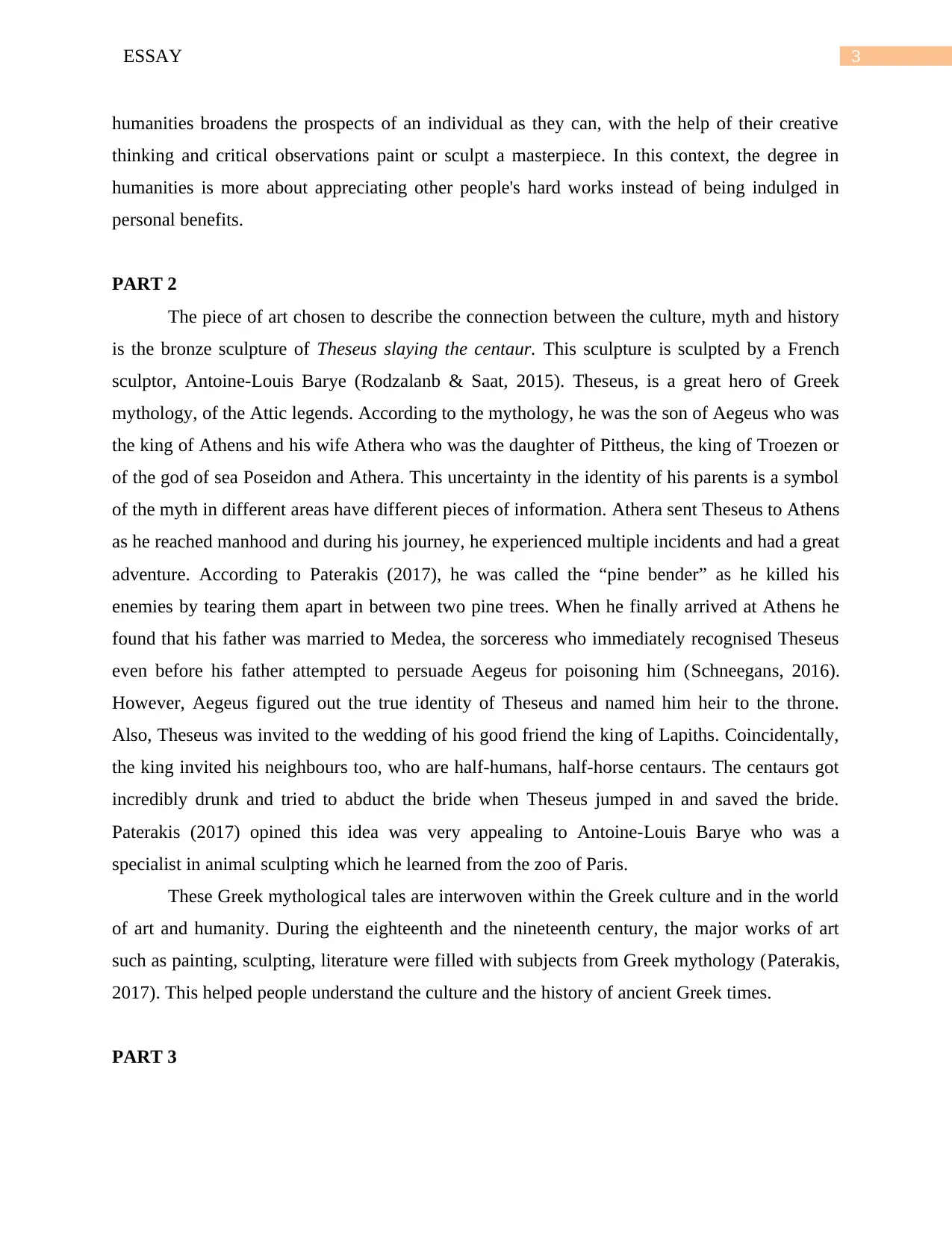
3ESSAY
humanities broadens the prospects of an individual as they can, with the help of their creative
thinking and critical observations paint or sculpt a masterpiece. In this context, the degree in
humanities is more about appreciating other people's hard works instead of being indulged in
personal benefits.
PART 2
The piece of art chosen to describe the connection between the culture, myth and history
is the bronze sculpture of Theseus slaying the centaur. This sculpture is sculpted by a French
sculptor, Antoine-Louis Barye (Rodzalanb & Saat, 2015). Theseus, is a great hero of Greek
mythology, of the Attic legends. According to the mythology, he was the son of Aegeus who was
the king of Athens and his wife Athera who was the daughter of Pittheus, the king of Troezen or
of the god of sea Poseidon and Athera. This uncertainty in the identity of his parents is a symbol
of the myth in different areas have different pieces of information. Athera sent Theseus to Athens
as he reached manhood and during his journey, he experienced multiple incidents and had a great
adventure. According to Paterakis (2017), he was called the “pine bender” as he killed his
enemies by tearing them apart in between two pine trees. When he finally arrived at Athens he
found that his father was married to Medea, the sorceress who immediately recognised Theseus
even before his father attempted to persuade Aegeus for poisoning him (Schneegans, 2016).
However, Aegeus figured out the true identity of Theseus and named him heir to the throne.
Also, Theseus was invited to the wedding of his good friend the king of Lapiths. Coincidentally,
the king invited his neighbours too, who are half-humans, half-horse centaurs. The centaurs got
incredibly drunk and tried to abduct the bride when Theseus jumped in and saved the bride.
Paterakis (2017) opined this idea was very appealing to Antoine-Louis Barye who was a
specialist in animal sculpting which he learned from the zoo of Paris.
These Greek mythological tales are interwoven within the Greek culture and in the world
of art and humanity. During the eighteenth and the nineteenth century, the major works of art
such as painting, sculpting, literature were filled with subjects from Greek mythology (Paterakis,
2017). This helped people understand the culture and the history of ancient Greek times.
PART 3
humanities broadens the prospects of an individual as they can, with the help of their creative
thinking and critical observations paint or sculpt a masterpiece. In this context, the degree in
humanities is more about appreciating other people's hard works instead of being indulged in
personal benefits.
PART 2
The piece of art chosen to describe the connection between the culture, myth and history
is the bronze sculpture of Theseus slaying the centaur. This sculpture is sculpted by a French
sculptor, Antoine-Louis Barye (Rodzalanb & Saat, 2015). Theseus, is a great hero of Greek
mythology, of the Attic legends. According to the mythology, he was the son of Aegeus who was
the king of Athens and his wife Athera who was the daughter of Pittheus, the king of Troezen or
of the god of sea Poseidon and Athera. This uncertainty in the identity of his parents is a symbol
of the myth in different areas have different pieces of information. Athera sent Theseus to Athens
as he reached manhood and during his journey, he experienced multiple incidents and had a great
adventure. According to Paterakis (2017), he was called the “pine bender” as he killed his
enemies by tearing them apart in between two pine trees. When he finally arrived at Athens he
found that his father was married to Medea, the sorceress who immediately recognised Theseus
even before his father attempted to persuade Aegeus for poisoning him (Schneegans, 2016).
However, Aegeus figured out the true identity of Theseus and named him heir to the throne.
Also, Theseus was invited to the wedding of his good friend the king of Lapiths. Coincidentally,
the king invited his neighbours too, who are half-humans, half-horse centaurs. The centaurs got
incredibly drunk and tried to abduct the bride when Theseus jumped in and saved the bride.
Paterakis (2017) opined this idea was very appealing to Antoine-Louis Barye who was a
specialist in animal sculpting which he learned from the zoo of Paris.
These Greek mythological tales are interwoven within the Greek culture and in the world
of art and humanity. During the eighteenth and the nineteenth century, the major works of art
such as painting, sculpting, literature were filled with subjects from Greek mythology (Paterakis,
2017). This helped people understand the culture and the history of ancient Greek times.
PART 3
⊘ This is a preview!⊘
Do you want full access?
Subscribe today to unlock all pages.

Trusted by 1+ million students worldwide
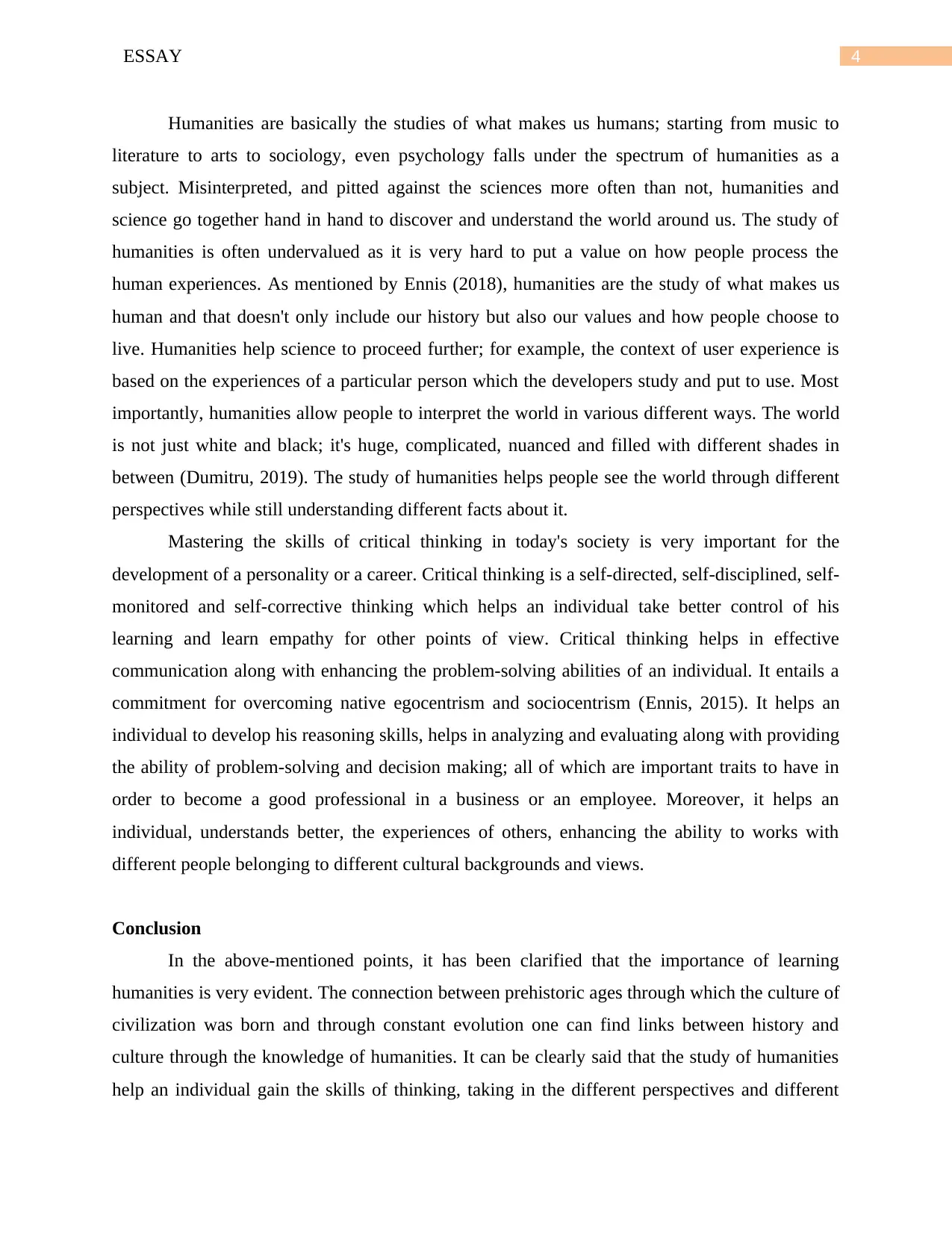
4ESSAY
Humanities are basically the studies of what makes us humans; starting from music to
literature to arts to sociology, even psychology falls under the spectrum of humanities as a
subject. Misinterpreted, and pitted against the sciences more often than not, humanities and
science go together hand in hand to discover and understand the world around us. The study of
humanities is often undervalued as it is very hard to put a value on how people process the
human experiences. As mentioned by Ennis (2018), humanities are the study of what makes us
human and that doesn't only include our history but also our values and how people choose to
live. Humanities help science to proceed further; for example, the context of user experience is
based on the experiences of a particular person which the developers study and put to use. Most
importantly, humanities allow people to interpret the world in various different ways. The world
is not just white and black; it's huge, complicated, nuanced and filled with different shades in
between (Dumitru, 2019). The study of humanities helps people see the world through different
perspectives while still understanding different facts about it.
Mastering the skills of critical thinking in today's society is very important for the
development of a personality or a career. Critical thinking is a self-directed, self-disciplined, self-
monitored and self-corrective thinking which helps an individual take better control of his
learning and learn empathy for other points of view. Critical thinking helps in effective
communication along with enhancing the problem-solving abilities of an individual. It entails a
commitment for overcoming native egocentrism and sociocentrism (Ennis, 2015). It helps an
individual to develop his reasoning skills, helps in analyzing and evaluating along with providing
the ability of problem-solving and decision making; all of which are important traits to have in
order to become a good professional in a business or an employee. Moreover, it helps an
individual, understands better, the experiences of others, enhancing the ability to works with
different people belonging to different cultural backgrounds and views.
Conclusion
In the above-mentioned points, it has been clarified that the importance of learning
humanities is very evident. The connection between prehistoric ages through which the culture of
civilization was born and through constant evolution one can find links between history and
culture through the knowledge of humanities. It can be clearly said that the study of humanities
help an individual gain the skills of thinking, taking in the different perspectives and different
Humanities are basically the studies of what makes us humans; starting from music to
literature to arts to sociology, even psychology falls under the spectrum of humanities as a
subject. Misinterpreted, and pitted against the sciences more often than not, humanities and
science go together hand in hand to discover and understand the world around us. The study of
humanities is often undervalued as it is very hard to put a value on how people process the
human experiences. As mentioned by Ennis (2018), humanities are the study of what makes us
human and that doesn't only include our history but also our values and how people choose to
live. Humanities help science to proceed further; for example, the context of user experience is
based on the experiences of a particular person which the developers study and put to use. Most
importantly, humanities allow people to interpret the world in various different ways. The world
is not just white and black; it's huge, complicated, nuanced and filled with different shades in
between (Dumitru, 2019). The study of humanities helps people see the world through different
perspectives while still understanding different facts about it.
Mastering the skills of critical thinking in today's society is very important for the
development of a personality or a career. Critical thinking is a self-directed, self-disciplined, self-
monitored and self-corrective thinking which helps an individual take better control of his
learning and learn empathy for other points of view. Critical thinking helps in effective
communication along with enhancing the problem-solving abilities of an individual. It entails a
commitment for overcoming native egocentrism and sociocentrism (Ennis, 2015). It helps an
individual to develop his reasoning skills, helps in analyzing and evaluating along with providing
the ability of problem-solving and decision making; all of which are important traits to have in
order to become a good professional in a business or an employee. Moreover, it helps an
individual, understands better, the experiences of others, enhancing the ability to works with
different people belonging to different cultural backgrounds and views.
Conclusion
In the above-mentioned points, it has been clarified that the importance of learning
humanities is very evident. The connection between prehistoric ages through which the culture of
civilization was born and through constant evolution one can find links between history and
culture through the knowledge of humanities. It can be clearly said that the study of humanities
help an individual gain the skills of thinking, taking in the different perspectives and different
Paraphrase This Document
Need a fresh take? Get an instant paraphrase of this document with our AI Paraphraser
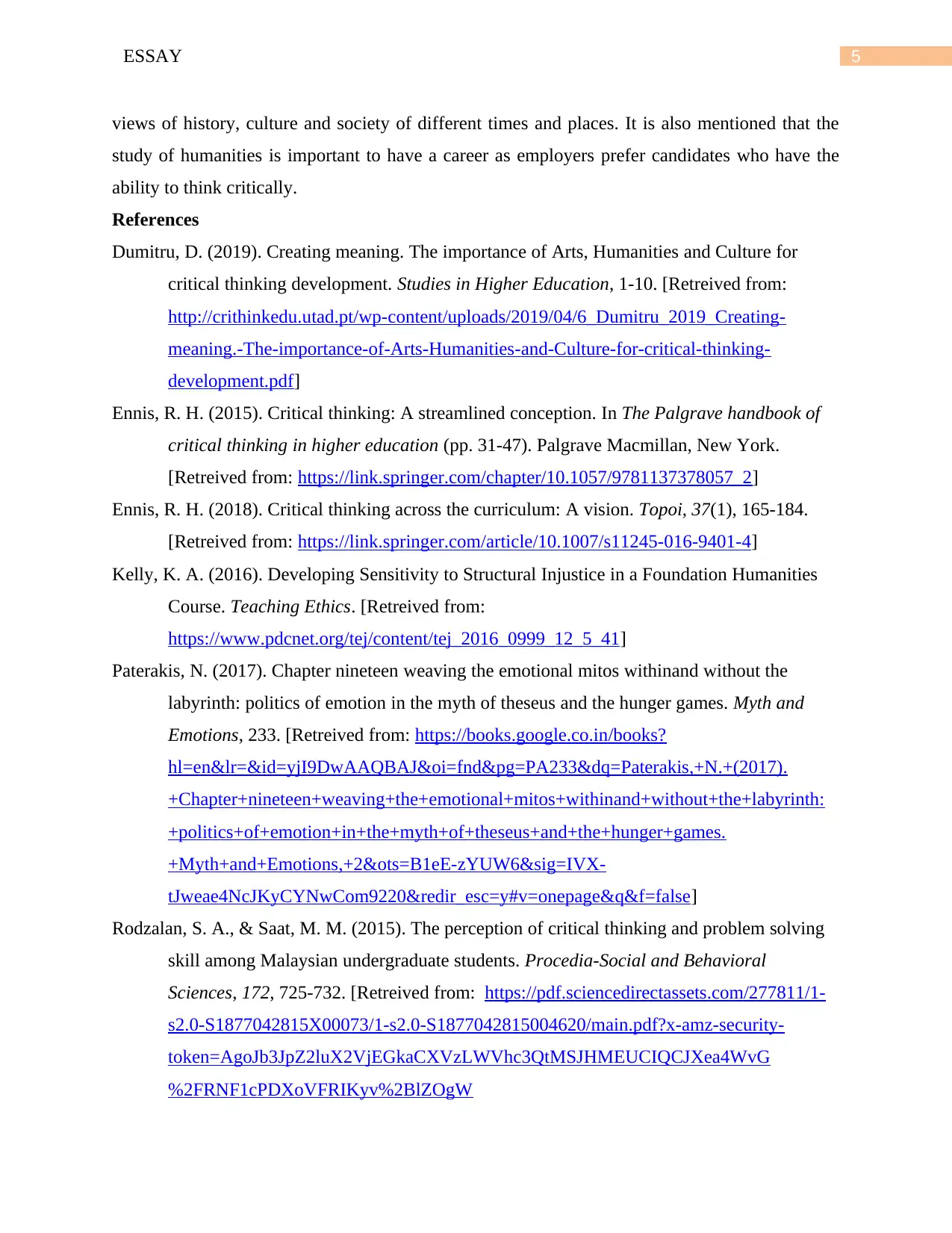
5ESSAY
views of history, culture and society of different times and places. It is also mentioned that the
study of humanities is important to have a career as employers prefer candidates who have the
ability to think critically.
References
Dumitru, D. (2019). Creating meaning. The importance of Arts, Humanities and Culture for
critical thinking development. Studies in Higher Education, 1-10. [Retreived from:
http://crithinkedu.utad.pt/wp-content/uploads/2019/04/6_Dumitru_2019_Creating-
meaning.-The-importance-of-Arts-Humanities-and-Culture-for-critical-thinking-
development.pdf]
Ennis, R. H. (2015). Critical thinking: A streamlined conception. In The Palgrave handbook of
critical thinking in higher education (pp. 31-47). Palgrave Macmillan, New York.
[Retreived from: https://link.springer.com/chapter/10.1057/9781137378057_2]
Ennis, R. H. (2018). Critical thinking across the curriculum: A vision. Topoi, 37(1), 165-184.
[Retreived from: https://link.springer.com/article/10.1007/s11245-016-9401-4]
Kelly, K. A. (2016). Developing Sensitivity to Structural Injustice in a Foundation Humanities
Course. Teaching Ethics. [Retreived from:
https://www.pdcnet.org/tej/content/tej_2016_0999_12_5_41]
Paterakis, N. (2017). Chapter nineteen weaving the emotional mitos withinand without the
labyrinth: politics of emotion in the myth of theseus and the hunger games. Myth and
Emotions, 233. [Retreived from: https://books.google.co.in/books?
hl=en&lr=&id=yjI9DwAAQBAJ&oi=fnd&pg=PA233&dq=Paterakis,+N.+(2017).
+Chapter+nineteen+weaving+the+emotional+mitos+withinand+without+the+labyrinth:
+politics+of+emotion+in+the+myth+of+theseus+and+the+hunger+games.
+Myth+and+Emotions,+2&ots=B1eE-zYUW6&sig=IVX-
tJweae4NcJKyCYNwCom9220&redir_esc=y#v=onepage&q&f=false]
Rodzalan, S. A., & Saat, M. M. (2015). The perception of critical thinking and problem solving
skill among Malaysian undergraduate students. Procedia-Social and Behavioral
Sciences, 172, 725-732. [Retreived from: https://pdf.sciencedirectassets.com/277811/1-
s2.0-S1877042815X00073/1-s2.0-S1877042815004620/main.pdf?x-amz-security-
token=AgoJb3JpZ2luX2VjEGkaCXVzLWVhc3QtMSJHMEUCIQCJXea4WvG
%2FRNF1cPDXoVFRIKyv%2BlZOgW
views of history, culture and society of different times and places. It is also mentioned that the
study of humanities is important to have a career as employers prefer candidates who have the
ability to think critically.
References
Dumitru, D. (2019). Creating meaning. The importance of Arts, Humanities and Culture for
critical thinking development. Studies in Higher Education, 1-10. [Retreived from:
http://crithinkedu.utad.pt/wp-content/uploads/2019/04/6_Dumitru_2019_Creating-
meaning.-The-importance-of-Arts-Humanities-and-Culture-for-critical-thinking-
development.pdf]
Ennis, R. H. (2015). Critical thinking: A streamlined conception. In The Palgrave handbook of
critical thinking in higher education (pp. 31-47). Palgrave Macmillan, New York.
[Retreived from: https://link.springer.com/chapter/10.1057/9781137378057_2]
Ennis, R. H. (2018). Critical thinking across the curriculum: A vision. Topoi, 37(1), 165-184.
[Retreived from: https://link.springer.com/article/10.1007/s11245-016-9401-4]
Kelly, K. A. (2016). Developing Sensitivity to Structural Injustice in a Foundation Humanities
Course. Teaching Ethics. [Retreived from:
https://www.pdcnet.org/tej/content/tej_2016_0999_12_5_41]
Paterakis, N. (2017). Chapter nineteen weaving the emotional mitos withinand without the
labyrinth: politics of emotion in the myth of theseus and the hunger games. Myth and
Emotions, 233. [Retreived from: https://books.google.co.in/books?
hl=en&lr=&id=yjI9DwAAQBAJ&oi=fnd&pg=PA233&dq=Paterakis,+N.+(2017).
+Chapter+nineteen+weaving+the+emotional+mitos+withinand+without+the+labyrinth:
+politics+of+emotion+in+the+myth+of+theseus+and+the+hunger+games.
+Myth+and+Emotions,+2&ots=B1eE-zYUW6&sig=IVX-
tJweae4NcJKyCYNwCom9220&redir_esc=y#v=onepage&q&f=false]
Rodzalan, S. A., & Saat, M. M. (2015). The perception of critical thinking and problem solving
skill among Malaysian undergraduate students. Procedia-Social and Behavioral
Sciences, 172, 725-732. [Retreived from: https://pdf.sciencedirectassets.com/277811/1-
s2.0-S1877042815X00073/1-s2.0-S1877042815004620/main.pdf?x-amz-security-
token=AgoJb3JpZ2luX2VjEGkaCXVzLWVhc3QtMSJHMEUCIQCJXea4WvG
%2FRNF1cPDXoVFRIKyv%2BlZOgW
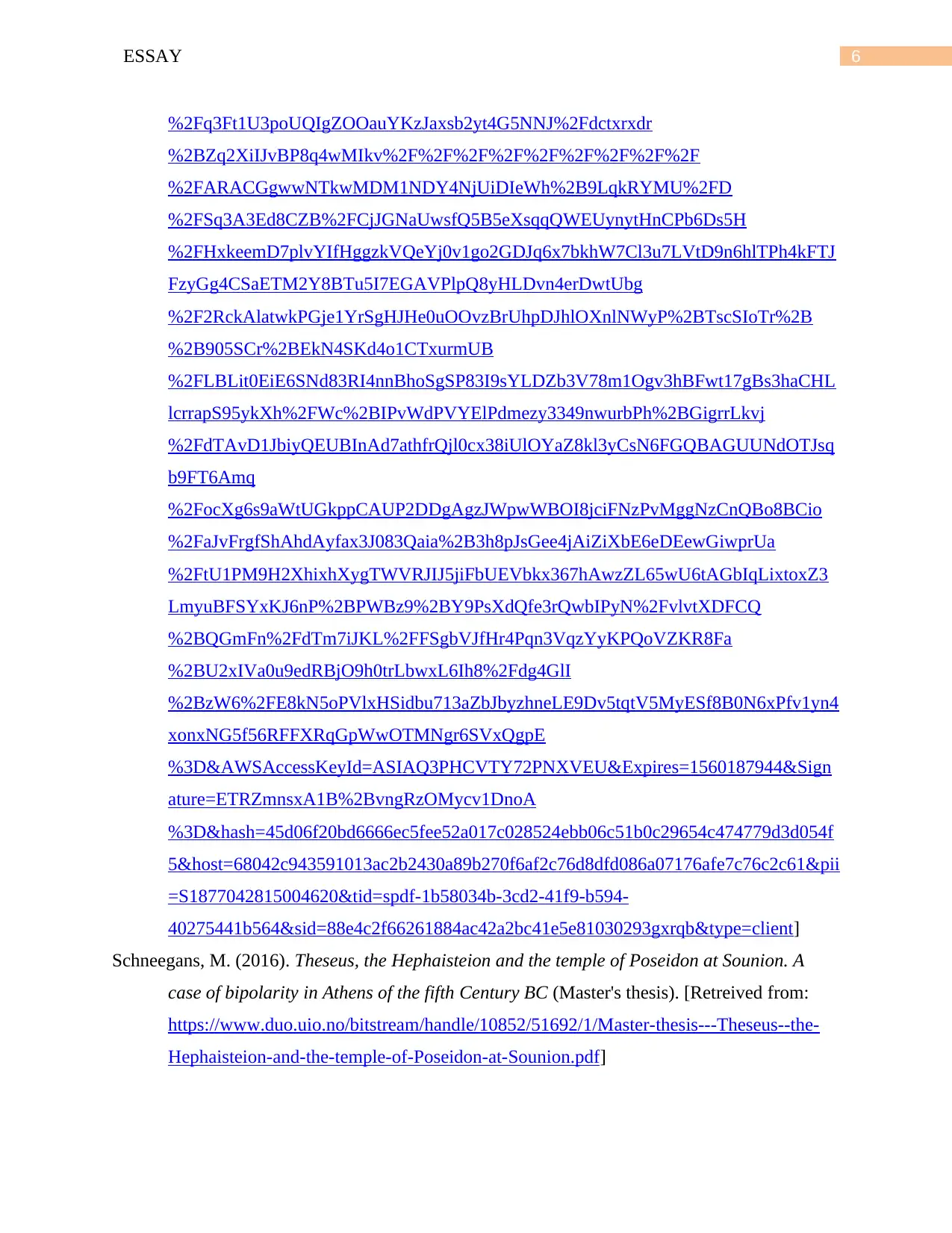
6ESSAY
%2Fq3Ft1U3poUQIgZOOauYKzJaxsb2yt4G5NNJ%2Fdctxrxdr
%2BZq2XiIJvBP8q4wMIkv%2F%2F%2F%2F%2F%2F%2F%2F%2F
%2FARACGgwwNTkwMDM1NDY4NjUiDIeWh%2B9LqkRYMU%2FD
%2FSq3A3Ed8CZB%2FCjJGNaUwsfQ5B5eXsqqQWEUynytHnCPb6Ds5H
%2FHxkeemD7plvYIfHggzkVQeYj0v1go2GDJq6x7bkhW7Cl3u7LVtD9n6hlTPh4kFTJ
FzyGg4CSaETM2Y8BTu5I7EGAVPlpQ8yHLDvn4erDwtUbg
%2F2RckAlatwkPGje1YrSgHJHe0uOOvzBrUhpDJhlOXnlNWyP%2BTscSIoTr%2B
%2B905SCr%2BEkN4SKd4o1CTxurmUB
%2FLBLit0EiE6SNd83RI4nnBhoSgSP83I9sYLDZb3V78m1Ogv3hBFwt17gBs3haCHL
lcrrapS95ykXh%2FWc%2BIPvWdPVYElPdmezy3349nwurbPh%2BGigrrLkvj
%2FdTAvD1JbiyQEUBInAd7athfrQjl0cx38iUlOYaZ8kl3yCsN6FGQBAGUUNdOTJsq
b9FT6Amq
%2FocXg6s9aWtUGkppCAUP2DDgAgzJWpwWBOI8jciFNzPvMggNzCnQBo8BCio
%2FaJvFrgfShAhdAyfax3J083Qaia%2B3h8pJsGee4jAiZiXbE6eDEewGiwprUa
%2FtU1PM9H2XhixhXygTWVRJIJ5jiFbUEVbkx367hAwzZL65wU6tAGbIqLixtoxZ3
LmyuBFSYxKJ6nP%2BPWBz9%2BY9PsXdQfe3rQwbIPyN%2FvlvtXDFCQ
%2BQGmFn%2FdTm7iJKL%2FFSgbVJfHr4Pqn3VqzYyKPQoVZKR8Fa
%2BU2xIVa0u9edRBjO9h0trLbwxL6Ih8%2Fdg4GlI
%2BzW6%2FE8kN5oPVlxHSidbu713aZbJbyzhneLE9Dv5tqtV5MyESf8B0N6xPfv1yn4
xonxNG5f56RFFXRqGpWwOTMNgr6SVxQgpE
%3D&AWSAccessKeyId=ASIAQ3PHCVTY72PNXVEU&Expires=1560187944&Sign
ature=ETRZmnsxA1B%2BvngRzOMycv1DnoA
%3D&hash=45d06f20bd6666ec5fee52a017c028524ebb06c51b0c29654c474779d3d054f
5&host=68042c943591013ac2b2430a89b270f6af2c76d8dfd086a07176afe7c76c2c61&pii
=S1877042815004620&tid=spdf-1b58034b-3cd2-41f9-b594-
40275441b564&sid=88e4c2f66261884ac42a2bc41e5e81030293gxrqb&type=client]
Schneegans, M. (2016). Theseus, the Hephaisteion and the temple of Poseidon at Sounion. A
case of bipolarity in Athens of the fifth Century BC (Master's thesis). [Retreived from:
https://www.duo.uio.no/bitstream/handle/10852/51692/1/Master-thesis---Theseus--the-
Hephaisteion-and-the-temple-of-Poseidon-at-Sounion.pdf]
%2Fq3Ft1U3poUQIgZOOauYKzJaxsb2yt4G5NNJ%2Fdctxrxdr
%2BZq2XiIJvBP8q4wMIkv%2F%2F%2F%2F%2F%2F%2F%2F%2F
%2FARACGgwwNTkwMDM1NDY4NjUiDIeWh%2B9LqkRYMU%2FD
%2FSq3A3Ed8CZB%2FCjJGNaUwsfQ5B5eXsqqQWEUynytHnCPb6Ds5H
%2FHxkeemD7plvYIfHggzkVQeYj0v1go2GDJq6x7bkhW7Cl3u7LVtD9n6hlTPh4kFTJ
FzyGg4CSaETM2Y8BTu5I7EGAVPlpQ8yHLDvn4erDwtUbg
%2F2RckAlatwkPGje1YrSgHJHe0uOOvzBrUhpDJhlOXnlNWyP%2BTscSIoTr%2B
%2B905SCr%2BEkN4SKd4o1CTxurmUB
%2FLBLit0EiE6SNd83RI4nnBhoSgSP83I9sYLDZb3V78m1Ogv3hBFwt17gBs3haCHL
lcrrapS95ykXh%2FWc%2BIPvWdPVYElPdmezy3349nwurbPh%2BGigrrLkvj
%2FdTAvD1JbiyQEUBInAd7athfrQjl0cx38iUlOYaZ8kl3yCsN6FGQBAGUUNdOTJsq
b9FT6Amq
%2FocXg6s9aWtUGkppCAUP2DDgAgzJWpwWBOI8jciFNzPvMggNzCnQBo8BCio
%2FaJvFrgfShAhdAyfax3J083Qaia%2B3h8pJsGee4jAiZiXbE6eDEewGiwprUa
%2FtU1PM9H2XhixhXygTWVRJIJ5jiFbUEVbkx367hAwzZL65wU6tAGbIqLixtoxZ3
LmyuBFSYxKJ6nP%2BPWBz9%2BY9PsXdQfe3rQwbIPyN%2FvlvtXDFCQ
%2BQGmFn%2FdTm7iJKL%2FFSgbVJfHr4Pqn3VqzYyKPQoVZKR8Fa
%2BU2xIVa0u9edRBjO9h0trLbwxL6Ih8%2Fdg4GlI
%2BzW6%2FE8kN5oPVlxHSidbu713aZbJbyzhneLE9Dv5tqtV5MyESf8B0N6xPfv1yn4
xonxNG5f56RFFXRqGpWwOTMNgr6SVxQgpE
%3D&AWSAccessKeyId=ASIAQ3PHCVTY72PNXVEU&Expires=1560187944&Sign
ature=ETRZmnsxA1B%2BvngRzOMycv1DnoA
%3D&hash=45d06f20bd6666ec5fee52a017c028524ebb06c51b0c29654c474779d3d054f
5&host=68042c943591013ac2b2430a89b270f6af2c76d8dfd086a07176afe7c76c2c61&pii
=S1877042815004620&tid=spdf-1b58034b-3cd2-41f9-b594-
40275441b564&sid=88e4c2f66261884ac42a2bc41e5e81030293gxrqb&type=client]
Schneegans, M. (2016). Theseus, the Hephaisteion and the temple of Poseidon at Sounion. A
case of bipolarity in Athens of the fifth Century BC (Master's thesis). [Retreived from:
https://www.duo.uio.no/bitstream/handle/10852/51692/1/Master-thesis---Theseus--the-
Hephaisteion-and-the-temple-of-Poseidon-at-Sounion.pdf]
⊘ This is a preview!⊘
Do you want full access?
Subscribe today to unlock all pages.

Trusted by 1+ million students worldwide
1 out of 6
Related Documents
Your All-in-One AI-Powered Toolkit for Academic Success.
+13062052269
info@desklib.com
Available 24*7 on WhatsApp / Email
![[object Object]](/_next/static/media/star-bottom.7253800d.svg)
Unlock your academic potential
Copyright © 2020–2025 A2Z Services. All Rights Reserved. Developed and managed by ZUCOL.





